Siege of Los Angeles and Fort Moore/Fort Hill
Introduction
Text-to-speech Audio
Images
Fort Moore Hill in 1900. Banning Mansion on top of hill
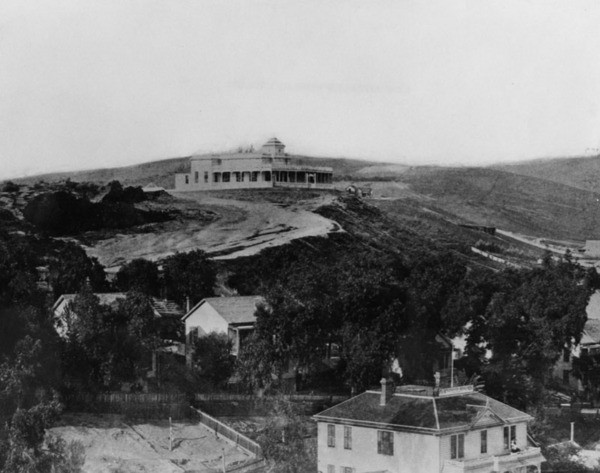
Section of Fort Moore Pioneer Memorial showing raising of American flag in 1847. The flag was raised by the Mormon Battaltion
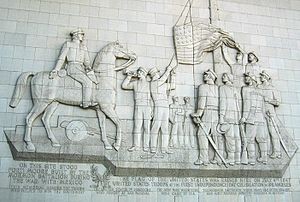
Fort Moore Pioneer Memorial
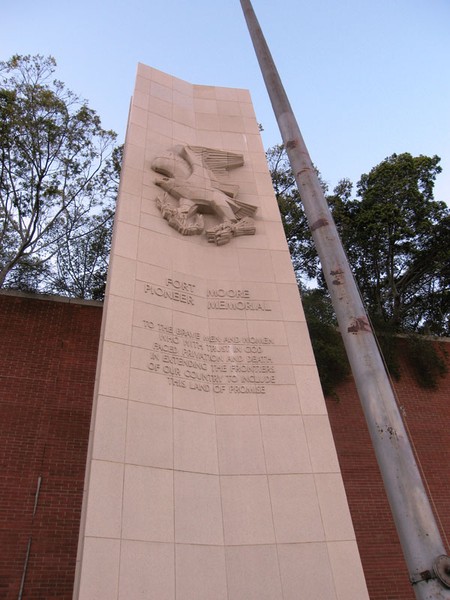
LAHS in 1908 on Fort Moore Hill
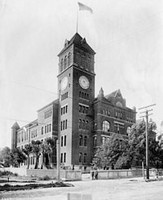
Capt. Robert Stockton taken a few years after Mexican War
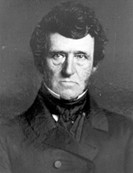
Backstory and Context
Text-to-speech Audio
Following the Battle Monterey, the Americans held northern California but General Jose Maria Castro and Governor Pio Pico planned resistance in the south around the Los Angeles area. Commodore Robert F. Stockton arrived at Monterey Bay aboard the Congress on 15 July and took over command from John D. Sloat. Stockton accepted the Bear Flag revolutionaries, under the command of Major John C. Fremont, as the California Battalion/ Stockton then garrisoned Sonoma, San Juan Bautista, Santa Clara, and Sutter's Fort. Stockton's plan for dealing with Castro was to have Commander Samuel Francis Du Pont carry Fremont's men in the Cyane to San Diego to block any movement southwards, while Stockton would land a force at San Pedro which would move overland against Castro. Fremont arrived at San Diego on 29 July and reached San Pedro on 6 August aboard the Congress.
Upon holding a council of war, Castro decided to leave California, heading to Sonora with Pico and a few supporters on 11 August, while the rest of his force retired to Rancho San Pascual. On 13 August 13 1846, Stockton led his columnn into town, followed by Fremont's force a half hour later. On the 14 August, the remnants of the California army surrendered. Stockton established a garrison of forty-eight men under Capt. Archibald H. Gillespie and departed in September. His men, however, were undisciplined in an area with pro-Mexican feelings.
On 23 September, twenty men under the command of Cerbulo Varela exchanged shots with the Americans at Government House, which ignited Los Angeles. On 24 September, 150 Californios, organized under Jose Maria Flores, a Mexican Officer who remained in California, at Castro's old camp at La Mesa. Gillespie's forces were effectively besieged, while Gillespie sent Juan "Flaco" Brown to Commodore Stockton for help.
Gillespie's men retreated to Fort Hill on 28 September, but without water, they surrendered the next day. Terms called for Gillespie's men to leave Los Angeles, which they did on 30 September 1846, and boarded the American merchant vessel Vandalia.
Flores quickly cleared remaining American forces in southern California. It would take many more battles/skirmishes with Mexican and loyalist Californio forces for American forces to successfully complete the recapture of Los Angeles.
Fort Moore:
The harsh martial law of Captain Gillespie soon ignited a popular uprising among loyalist Californios and Mexicans led by General Jose Maria Flores beginning on September 22, 1846 to retake Los Angeles. Gillespie's 50 marines were able to resist an initial attack on the government house in town and regrouped on Fort Hill, where they strengthened the fortification with sandbags and mounted their cannon. As time passed, the Californio forces opposing the U.S. takeover grew to just over 600 men, with several Californio citizens voicing opposition. General Flores offered an ultimatum: leave within 24 hours or face attack. Gillespie agreed to withdraw from Los Angeles, under safe passage, on September 30, 1846.
On October 7, the U.S. forces regrouped, with Commodore Stockton sending 350 Americans, including 200 U.S. Marines, under U.S. Navy Capt. William Mervine, to retake Los Angeles. The marines were defeated in their attempt at the Battle of Dominguez Rancho, as Stockton's fleet fled south to San Diego. In December, U.S. Army forces under Captain Stephen W. Kearny were defeated by the Californio Lancers at the Battle of San Pasqual. After regrouping and resupplying forces in San Diego, on January 10, 1847, Los Angeles was recaptured by the combined 700 man forces of John C. Fremont, Stockton and Kearny, after the Battle of Rio San Gabriel and the Battle of La Meas. With the signing of the Treaty of Cahuenga on January 13, 1847, war in Alta California (Upper California) ended.
On January 12, 1847, to secure the area from future attack, U.S. forces began erecting a 400-foot long breastwork on the same strategic site as the previous Fort Hill and named it the Post at Los Angeles. The plans were later revised, and on April 23 a larger defensive structure was begun on the same site. Constructed by the Mormon Battalion and the US First Dragoons, it was designed for six cannons. It was never completed and was dedicated as Fort Moore on July 4, 1847, named after Captain Benjamin D. Moore, 1st Dragoons, one of 22 Americans killed in the Battle of San Pasqual in San Diego County, on December 6, 1846.
Lieutenant William T. Sherman ordered the garrison withdrawn in 1848, and the fort was abandoned in 1849 and decommissioned in 1853. Part of the hill would become a cemetery. The cemetery was overseen by the city starting in 1869. It was not well taken care of, lacking clearly delineated boundaries, complete records or adequate maintenance. The Los Angeles City Council passed a resolution on August 30, 1879, closing the cemetery to any future burials except for those with already reserved plots. By 1884, the city had sold portions of the cemetery as residential lots and the rest to the Los Angeles Board of Education (later the Los Angeles Unified School District or LAUSD).
The city never removed any bodies, and the former cemetery was the site of repeated, grisly findings and much negative press. As a result, the city began moving the bodies, most to Evergreen Cemetery, Rosedale Cemetery and Hollywood Memorial Park Cemetery, with the final bodies being transferred in May 1947. The recent construction of Los Angeles High School #9 resulted in the discovery of additional human remains. These were excavated by archaeologists in 2006.
In 1891, the site became home to the second location of Los Angeles High School (LAHS),. LAHS was at this location on Fort Moore Hill until 1917, when the high school was moved again. Part of the site was later replaced by the headquarters of the LAUSD. Because of political and financial hardship caused by the construction of the nearby Belmont Learning Center, the LAUSD moved from the location in 2001 so that a new high school could be built on its location.
The new high school, formerly named Central Los Angeles Area New High School #9, is now named Roman C. Cortines School of Visual and Performing Arts and is a part of the adjacent Los Angeles Cultural Corridor.
Most of Fort Moore Hill was removed in 1949 for the construction of the Hollywood Freeway, which was opened in December 1950, and in 1957 a memorial for the old fort and its American pioneers was placed on a site north of the freeway.
The Fort Moore Pioneer Memorial is a large stone memorial wall built in 1957 on part of the original location of Fort Moore facing North Hill Street.
As the largest bas-relief military monument in the United States, it honors the Mormon Battalion, the U.S. 1st Dragoons, and the New York Volunteers who raised the American Flag over the fort on July 4, 1847, at the first Independence Day in Los Angeles.
Funded by Los Angeles County, the City of Los Angeles, the Los Angeles Board of Education and the Department of Water and Power, the memorial was designed by Kazumi Adachi and Dike Nagano and dedicated on July 3, 1957. Featuring four different panels, a 78 feet by 45 feet panel designed by Saltus Award-winner Henry Kries is the most prominent feature and portrays the July 4 event.
Other panels represent the agricultural and spiritual foundation of the region; transportation that shaped the city at the end of the 19th century; and the crucial role that water and electricity play in a large modern city.
